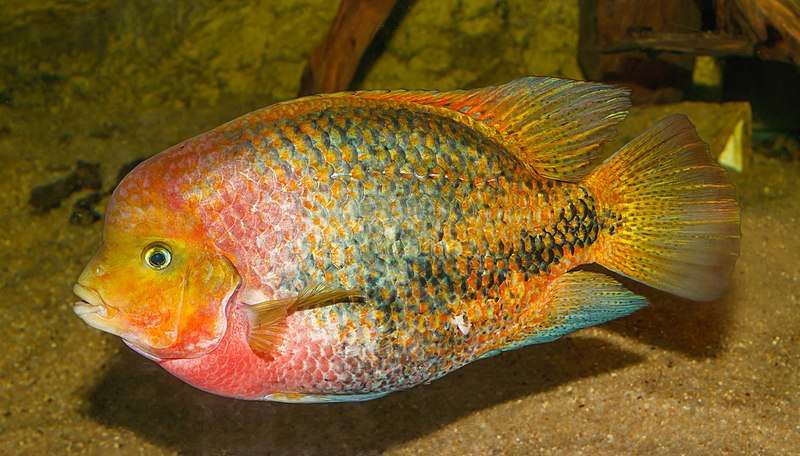
Size
14-16 inches (35.5-40.6 cm)
Physical Characteristics and Behavior
Male redhead cichlids exhibit one of the broadest color spectrums of any freshwater fish. Males in their mature state have a stocky, oval body with metallic green, blue, pink, and orange coloring. They typically have a pinkish-red hue with a nuchal bump on their heads. These amazing fish typically reach sizes of up to 16 inches. You’ll need a tank with a minimum 55-gallon capacity and a sizable base with lots of open water, rocks, roots, and driftwood for the solitary fish to explore. The redhead cichlid, which is moderately aggressive, might be kept in a communal tank with other African cichlids, but you shouldn’t rely on it.
Pet in Captivity

- Tank setup and care
Redhead cichlids are very majestic and long-lived species that are definitely worth your time and effort to care for them properly. Here are some pointers for setting up your aquarium for Redhead cichlids and for giving them the best care.
- Water Condition
The habitat of this species should have the following qualities: The 55-gallon (210-liter) tank’s specifications are as follows: Water should be between 23.9 and 27.1 degrees Celsius, 75.0 to 80.0 degrees Fahrenheit, and 6.8 to 8.2 on the pH scale (166.7-250 ppm).
- Size of Aquarium
Redhead cichlids, as we previously mentioned, can get quite big, so you need to make sure your tank is roomy. The recommended tank size for a single adult Redhead cichlid is at least 70 gallons long. If you plan on keeping a breeding pair, we recommend a tank size of at least 120 gallons. Choose a tank that is 135 gallons or larger if you wish to keep a group of young fish (more than four) together to get a pair. Naturally, a bigger aquarium is usually preferable so that your Redhead cichlids have more room to swim and explore. The additional room can help your Redhead cichlids live in a less stressful environment by lowering aggressiveness levels and preventing territorial disputes.
- Tank Substrate and Decoration
Male redhead cichlids exhibit one of the broadest color spectrums of any freshwater fish. Males in their mature state have a stocky, oval body with metallic green, blue, pink, and orange coloring. They typically have a pinkish-red hue with a nuchal bump on their heads. These amazing fish typically reach sizes of up to 16 inches. You’ll need a tank with a minimum 55-gallon capacity and a sizable base with lots of open water, rocks, roots, and driftwood for the solitary fish to explore. The redhead cichlid, which is moderately aggressive, might be kept in a communal tank with other African cichlids, but you shouldn’t rely on it.
- Food
Redhead cichlids eat mostly plants, although they also occasionally eat some live things. They eat insects, tiny crustaceans, and plant materials in the wild. They are not picky eaters in captivity and will consume a range of things. We advise feeding your Redhead cichlid a variety diet that includes both plant-based and meaty meals in order to keep them healthy and give them all the nutrients they require. Your best bet is to use high-quality cichlid pellet or flake food as the main diet. To enhance their stunning hues and enable them to reach their maximum potential, you should also provide them access to some protein-rich snacks.
Live or frozen foods like brine shrimp, bloodworms, blackworms, and krill are some excellent alternatives. Additionally, you can give them blanched vegetables like zucchini, broccoli, and spinach a few times per week.
- Tank companions
If you choose to keep more than one Redhead cichlid, we advise keeping at least four so that they may establish their own hierarchy and lessen aggression. In a communal aquarium, sturdy, comparable-sized Central American cichlids would make good tank mates for Redhead cichlids. Eventually, your fish may be able to coexist peacefully, depending on their personalities and the environment you create.
Here are some suitable species to try, provided your tank is big enough:
- Chocolate Cichlid
- Tiger Barbs
- Severum Cichlid
- Bristlenose Pleco
- Lemon Tetras
- Corys
Table





